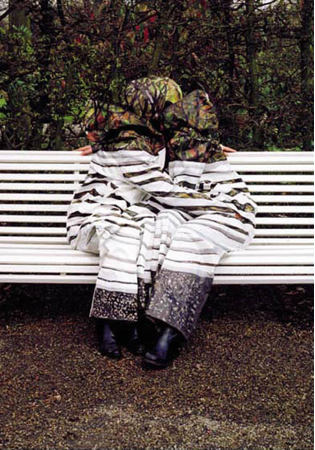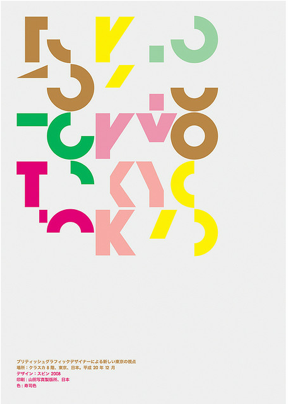
Park Bench / Couple (2001) by Desiree Palmen
Camouflage was designed to hide things, but how it changed our worldview may be its most revealing surprise. This five-part series examines the history of camo, from its humble origins to its current ubiquity. Catch up with Part I, Part II, Part III, Part IV, Part V.
PART ONE: Animals and Artists
We think of camouflage as a distinctive pattern, a concrete thing. But the real history of camouflage is a history of action—it’s much more verb than noun.
That verb itself is less obvious than you might think, too. Camouflage wasn’t only, or even primarily, concerned with hiding. It was also about being seen: confusing the eye, subverting reality, asserting both individuality and group identities. Camouflage is a pattern, a collection of conflicting verbs, and a surprisingly multivalent worldview.
Camouflage arose from a perfect intellectual storm in the early 20th century, drawing on theories of natural selection, Gestalt psychology, optics and cognition. On the eve of World War I—in which aerial combat played a newly prominent role—the world woke up to the idea that parading into war adorned in brilliant scarlet or blue trousers was less-than-smart. You might want to hide those expensive tanks, munitions factories and other assets from attack, too.
So began the improbable story of military camouflage, uniting a motley cast of thousands—from long-haired artists and zoologists to crew-cut youths from Japan to Nebraska—in perhaps the most democratic visual literacy course ever taught. Camouflage’s purpose expanded in World War II from simply hiding people and objects to creating an entire industry of visual subterfuge. It’s a story of inflatable tanks; decoy heads, tree-stumps and cities; magicians sporting colonel stripes; jazzy warships—a graphic pattern writ large and three-dimensional.
Camouflage’s non-military evolution is similarly paradoxical: It’s a visual stamp intended to stand out even as it blends in. With hundreds of patterns and dozens of conflicting uses—from hobnobbing 1920s flappers to Public Enemy to proud redneck prom queens—camouflage embodies our era’s cultural wars as much as its military conflicts.
Camo in Nature
Zoologist number one, Sir Edward Poulton, wrote the first book on camouflage in 1890. An ardent Darwinist before it was fashionable, Poulton saw animal mimicry for concealment as proof of natural selection. Whether masquerading as a twig, a wood ant (when actually a rove beetle), or a poisonous valentine pufferfish (when actually harmless), mimicry is a bluffer’s gift used by predators and prey alike.
Abbott Thayer, the American painter, popularized two key ideas in camouflage: countershading and disruptive coloration. Countershading explains why so many animals have lighter underbelly shading into a darker top. This visual effect cancels out shadowing from overhead sun, rendering the animal flat- and insubstantial-looking. Disruptive coloration refers to any irregular patterning in an animal’s coloration that disrupts its contours, making it more difficult to perceive at a distance.
A crotchety painter of pellucid angels, Thayer suffered from bipolar disorder. As his theories gained prominence (and attracted strong critique), Thayer succumbed to panic attacks, while writing with increasingly focused zeal in his own defense.
The second British zoologist, Hugh Cott, built on these concepts and added his own: contour obliteration and shadow elimination, among others. Inconspicuousness, bluff and legerdemain, sanctioned by Science: All of these concepts would later be put into action by military camouflage units.
This NPR Science Friday video shows the mimic wizardry of cephalopods, from cuttlefish to octopi. Chromatophores in their skin enable them to match color, pattern, even physical texture and shape with their environment.
Gestalt Theory, Optics, Arts
These concepts were simultaneously floating in the water in other disciplines. Founded in 1910, Gestalt psychology sought to understand “unit-forming factors” in how we perceive forms. The Gestalt notion of continuity—a moving gaze’s tendency to continue in a given direction—could be harnessed to misdirect enemy attention. Camouflage could be unwittingly undone by closure—the mind’s attempt to “connect the dots” of incomplete forms.
Visual artists also fell in thrall to these perceptual games. Pointillists like Seurat in the late 19th century broke their images into tiny optical dots, while Cubists and Vorticists of the early 20th century tried to show multiple perspectives on a flat canvas. Whether these artistic experiments authored military camouflage is an open question, but artists liked to think they were first. Seeing a camouflaged cannon rolling through Paris in World War I, Picasso exclaimed: “C’est nous qui avons fait ça!” (or “It is we who created that!”). Later he cultivated a breezily world-weary stance: “If they only want to make an army invisible at a distance,” he told poet Jean Cocteau, “they have only to dress their men as harlequins.”

Jude Stewart writes about design and culture for Slate, the Believer, Fast Company, and Print, among other publications. Her first book ROY G. BIV: An Exceedingly Surprising Book About Color is now available from Bloomsbury. Follow her on Twitter @joodstew.
Special thanks to Roy Behrens, Professor of Art at University of Northern Iowa and camouflage expert.




